Home decor can be a lot of fun, especially when it comes to decorating your bathroom. From tiles and fixtures to cabinets and countertops, the possibilities are endless. However, it’s important to have a plan in place before you start shopping. Here are some tips to get you started:
First, consider your budget and your functional needs. Once you have a clear idea of what you’re looking for, you can start exploring your options.
When it comes to bathroom fixtures, it’s important to choose ones that fit your design dreams. Whether you’re looking for a simple pedestal sink or a luxurious round tub, make sure it meets your needs and your budget.
In addition to fixtures, fittings are also important. They add the finishing touch to your bathroom and can be thought of as the “jewelry” of the space. Choose fittings that fit your design plan and add a touch of elegance to your bathroom.
Bathroom cabinets provide storage and can help hide items you don’t want on display. From practical to pretty, there are many cabinet ideas to choose from.
Countertops range from luxurious marble to durable laminates. Consider both function and attractiveness when choosing a countertop for your bathroom.
When it comes to floor and wall surfaces, diagonal tiles and vertical lines can create the illusion of more space. Explore your options and choose a surface that meets your needs and your style.
Lighting is also important in the bathroom. Consider your needs, such as applying makeup or creating a romantic mood, and choose lighting that meets those needs.
Finally, consider bathroom safety and maintenance. It’s important to design a safe bathroom, especially for those who need assistance. Easy cleaning is also an important factor to consider.
For more bathroom decorating and remodeling tips, visit:
- Designing a Bathroom
- Kids Bathroom Decorating Ideas
- Home Decorating Tips
Selecting Bathroom Fixtures
A damaged or worn fixture can be easily replaced without relocating it, making it a cost-effective way to redo a bathroom. Choose fixtures that meet your needs and fit your style. From a simple pedestal sink to a luxurious round tub, the possibilities are endless.
Pedestal and Wall-Hung Sinks
Pedestal and wall-hung sinks are perfect for small powder rooms or to create an elegant, sleek look in any bathroom. They are made of various materials such as enameled cast iron, vitreous china, stainless steel, solid surfacing, and even tempered art glass. These freestanding sinks come in versatile styles ranging from traditional to modern, and at the high end, they can be made of semiprecious stones or feature hand-painted basins.
One of their advantages is that they are easily accessible to wheelchair users, and wall-hung models can be adjusted to the right height. Additionally, sinks can be skirted to provide hidden storage, and glass or wood shelves can be installed above for open storage.
Lavatory (In-Counter) Sinks
If you need more counter space and storage, a sink can be dropped into a vanity. These sinks are usually made of vitreous china and come in undermount or self-rimming models. Undermount sinks attach to the underside of the counter, while self-rimming sinks rest on top of the counter. The latest look in self-rimming sinks is a simple bowl in hammered metal, art glass, water-resistant wood, or other materials that sit entirely above the countertop.
Integral bowl sinks fused to the countertop are a popular and economical choice. They are usually made of marble composite, solid surfacing, or other synthetic materials, and come in different geometric shapes, including round and hexagonal. Porcelain fixtures are also available with hand-painted traditional or modern motifs.
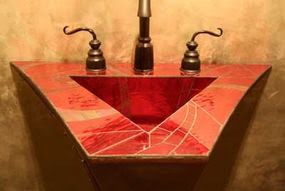
This triangular sink is enhanced by red mosaic tiles.
When choosing a sink, dark colors are dramatic and hide grime better than pastel or white sinks, but they are easily marked with soap scum and hard-water mineral deposits. Exotic colors may be attractive, but they can be off-putting to prospective buyers. Classic white, bone, and gray fixtures can be complemented by any color in towels, rugs, window treatments, wallcoverings, and accessories.
Fixtures are made of various materials such as vitreous china, porcelainized cast iron, enameled or porcelainized steel, cultured marble, and solid surfacing. Vitreous china is a classic and beautiful choice for all fixtures, while porcelainized cast iron is heavy and difficult to move. Enameled or porcelainized steel is less expensive but chips and dents easily. Cultured marble is popular and economical for integral sinks and counters, while solid-surfacing material is costlier but more durable.
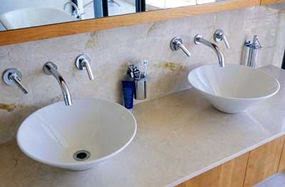
The double above-counter sink bowls have a sleek and modern appearance when paired with in-wall faucets.
New synthetic materials and combinations are frequently introduced to the market, however, china remains a timeless option that can be coordinated with all fixtures at any price point.
If you’re constructing a special tub or shower instead of using a prefabricated unit, you may have fixtures made from different materials. While toilets are typically made of vitreous china, sinks can be made of wood (with a tough plastic finish), stainless steel (look for 18-gauge instead of 20), or even ceramic tile.
These options allow you to coordinate the overall color and decorating style of your fixtures for a cohesive look. You can even visit an architectural salvage outlet to find pieces, both modern and vintage, that make a statement in your decorating. One word of caution: buy your fixtures and fittings at the same time to ensure they fit together. You don’t want to fall in love with a sink that requires a centerspread faucet after purchasing a widespread model!
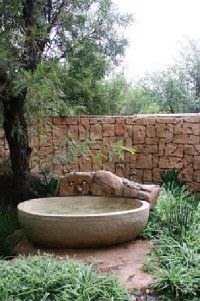
In warmer climates, an outdoor tub provides the opportunity for bathers to soak up the sun.
Bathtubs
Most conventional bathtubs are recessed, designed to fit into a bath recess with three sides concealed by walls and the fourth side left open as a finished front.
Recessed tubs typically measure between 30 to 33 inches in width and can range from 42 to 72 inches in length, although most are 60 inches. Most recessed bathtubs have a combination tub/shower to save space, but this style isn’t the safest.
The smooth, sloping sides of tubs are kind to backsides but slippery under wet feet, and experts recommend a separate tub and shower. Even in a small bathroom, a short soaking tub and an angled corner shower may make this possible.
Other bathtub options include the corner tub, a space-efficient way to incorporate a whirlpool; a freestanding tub, such as the vintage claw-foot style, for a nostalgic look; and the platform tub with the exposed side covered in tile or a floor-matching material for a “sunken tub” effect.
This last style works well in both modern and classical bathrooms inspired by ancient Rome.
Whirlpool Tubs
The whirlpool tub symbolizes the luxurious new style of baths since the late 1980s more than any other fixture. Many whirlpool tubs are 435 feet, and some are significantly larger, but if you need to maintain your existing bath footprint, look for one that’s five feet long but as narrow as a standard-size bathtub.
If you can alter the footprint but not the overall square footage of your bathroom, consider a whirlpool tub/shower combo or, better yet, a corner whirlpool and an angled shower.
Whirlpool tubs are typically made of top-of-the-line cast iron or somewhat less expensive acrylic and composites. They are commonly recessed or, particularly if they’re large, built into platforms.
Many early designs had steps up to the tub without a handrail, which was extremely dangerous. Nowadays, steps with a decorative, secure handrail or a higher, wider platform that allows bathers to sit on the edge of the whirlpool and swing their legs in are preferred for safety. Additionally, make sure your design permits you to access the controls from outside the tub.

Having an in-ground whirlpool tub is considered to be a symbol of luxury and extravagance. However, while installing a whirlpool tub, it is crucial to consider the weight problem it brings along with it. The large volume of water and the people using it adds a significant amount of weight, which can be too much for some homes’ structures, especially on the second floor. Therefore, additional shoring up will be necessary to avoid any accidents or damage to the property.

Before purchasing a tub, it is essential to check its hydrotherapy value. Make sure that water jets are positioned comfortably, and look for adjustable jets that allow you to regulate the proportion of air and water. A whirlpool amenity includes an in-line heater that keeps the water warm without having to refill it. Additionally, you can find features like two-speed motors, touch-pad controls, and a handheld shower extension. However, the latter can make it difficult to wash your hair as it requires one hand.
It is essential to think twice before investing in a large tub for two people, as it takes up more floor space and can be expensive. Unless you are among the rare couples who use it frequently, it is better to invest in other amenities.
Showers
To install a stall shower, you need a 36,336-inch space, which may be built in with only a slight slope of the floor toward the drain, eliminating the need for a shower door. Alternatively, you can opt for swing-out doors. With controls set into the wall, even a conventional tub/shower can offer the latest showering amenities. Modular shower systems are available that let you customize them with different shower floors, walls, and fittings. Multiple showerheads are great, and if you can install them into opposite walls, even an ordinary 60-inch tub can serve as a shower for two people.
A handheld showerhead with a wall-mounted pole that offers various height stations is an excellent option for kids or people with disabilities.

This bathroom feels spacious and airy due to its large mirror, floating sinks, and glass-enclosed half-round shower.
Toilets
Toilets are typically made of vitreous china and are available in various styles. The old-fashioned two-piece style with a round bowl mounted to the floor and a high tank on the wall is still available from a few manufacturers. The traditional “close-coupled” model has a separate water tank mounted on a round bowl. The modern one-piece model, also called the “low boy,” has a tank and bowl in one piece. For those who have the space, an elongated bowl, about two inches longer than the standard model in front, is a sophisticated alternative. It is available in both one-piece and two-piece designs. Taller or older people may find models with bowls 18 inches from the floor more comfortable than the standard 14 1/2 to 15 inches. These models usually come in two-piece units.
You can choose between “gravity-assist” and “pressure-assist” models in any style. By law, toilets produced after January 1, 1994, must use no more than 1.6 gallons of water per flush. In contrast, the older models used 3.5 to 10 gallons per flush.
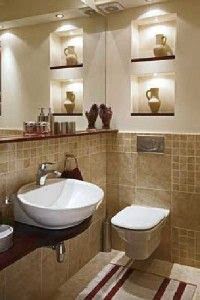
This modern bathroom features floating fixtures, which create an illusion of more space.
Different people have different opinions on the mandate to reduce water usage. While it helps in conserving water and reducing the burden on sewage-treatment plants, some consumers find that low-priced and midpriced models that rely solely on gravity assistance do not flush effectively. To aid flushing, the new gravity-assist models of the two-piece variety are taller and slimmer than in the past and have steeper bowls. However, some homeowners have gone to the extent of buying “bootleg” 3.5-gallon toilets in Canada, and some plumbing professionals have expressed concerns about potential public health dangers caused by inadequate flushing.
Some consumers have opted to purchase pressure-assist toilets that use compressed air to boost water velocity for more effective waste disposal. Although they are noisier and more expensive than gravity-assist models, they are considered to be more effective. Whatever type of toilet one chooses, it is important to keep dental floss, feminine hygiene products, paper towels, baby wipes, and facial tissue out of the toilet as they are not made to be flushed.
To save money on a toilet, one can choose a basic gravity-assist two-piece model in white. However, more effective pressure-assist flushing mechanisms, more color options, one-piece styling, elongated bowls, and 18-inch-tall bowls all add to the cost. At the high end, one can find more designer color choices, pressure-assist flushing, and elongated bowls as standard, specially decorated motifs as part of a fixture suite, choices of handles in different materials and finishes, and unobtrusive push buttons on top of the tank.
Toilets can be bought very economically, but if one is just redecorating and the toilet is in good shape, a new wood or plastic toilet seat can make the whole fixture look almost new for just a few dollars. In a cold house, padded toilet seats are recommended, but it is best to avoid those with embroidered butterflies or anything fussy.
A bidet is a sit-down washbasin that many Europeans consider a basic necessity for personal hygiene. In the ’80s, a bidet became a status element of the new, large American luxury bathroom, and today, most high-end bath fixture suites include a bidet, as do many mid-priced suites. It requires its own water supply and drain and is usually installed along the same wall as the toilet, 30 to 44 inches away.
For those who like the high humidity of steam or the dry heat of a sauna, they can create a health club at home with one or both of these fixtures. A steam shower is easier to install, as one can either install a self-contained unit or convert an existing shower into a steam room.
If you are looking to install a new shower module with a steam unit, you can expect features like a lighted dome top, a timer, and a seat. However, if you plan to convert an existing shower, it is important to ensure that the door seals completely before installing a steam generator. For those with solid-surfacing or acrylic shower walls, you should also check if they are steam-resistant to avoid damage.
The machinery for a sauna can be concealed in a vanity, but you will need a space of at least 434 square feet to create an enclosure that houses an electric heater topped with igneous periodite rocks. Water is ladled onto the hot rocks to produce humidity, and walls and benches are made of soft, aromatic woods like cedar or redwood. Saunas are available in precut and prefab kits. However, it is important to note that steam showers and saunas are not recommended for kids, pregnant women, or people with high blood pressure or heart problems.
When choosing fittings for your bathroom, you have many options to choose from, including faucet handles and spouts, pop-up drains, trip levers for the toilet, mixing valves for the shower, hand sprays, outlets, and controls in the whirlpool tub. If your fixtures are still in good condition, updating the fittings can give your bathroom a fresh look. New fittings also tend to operate more efficiently, and you can choose from a variety of styles, from traditional cross-handles to modern Eurostyle single-control units.
For shower fittings, you can select from single-handled or traditional separate hot and cold controls, along with various showerhead styles. To prevent shower accidents, make sure your showerhead has a pressure-balancing valve, especially if children, the disabled, or older people will be using the unit. Finally, remember to check out the available decorating and remodeling options for your bathroom.
A pressure-balancing valve is used to prevent sudden surges of hot water when someone flushes a toilet or turns on the washing machine. To prevent scalding, this valve works together with a high-temperature stop that is typically set by the plumber. Meanwhile, a towel hook can be a stylish alternative to a towel rack. High-quality fittings are often made with a brass base and can come in various finishes such as brass, chrome, gold, pewter, ceramic, enamel, crystal, plastic, and more. If you’re on a budget, you can opt for new brass fittings for your fixtures, or you can go for combination chrome-and-brass fittings. For storage, bathroom cabinetry is essential to keep the space organized and tidy. It’s important to plan for ample storage space, such as a spacious vanity, recessed shelving, open shelves for towels, or a linen closet outside the bathroom. Additionally, you can install a shallow cabinet or narrow tempered glass shelves above the toilet for extra storage.
Most cabinet makers create both kitchen and bathroom cabinets, so it’s worth checking if any kitchen units have the features you desire. Bathroom cabinets, like kitchen cabinets, can be stock units, semi-custom units that come in standard sizes but offer a choice of door styles or finishes, or custom-made units that fit your exact specifications. It’s recommended to request self-closing cabinet hinges and self-closing doors to prevent accidents from doors and drawers left ajar. The style options for bathroom cabinets are vast, from modern synthetic materials to traditional furniture-grade woods. Good-quality wood can be used in the bathroom if it has proper ventilation and a waterproof finish. Wood cabinets create a warm, natural contrast to the predominantly cooler materials used in the bathroom. Stained natural wood, colorwash stain, whitewashed bisque finish, waterproof opaque paint, or faux finish can be applied to bathroom cabinets. If floor space is limited, painting or staining built-in cabinets and freestanding pieces the same color as the walls can minimize visual clutter. Built-in cabinets can be “frameless” for a clean, modern look or conventional framed cabinetry for a traditional or contemporary look, depending on the door style. Slab or channel style gives a modern look, cathedral or curved raised panel gives a traditional, formal look, and board and batten gives a traditional, country style. A square raised panel door can look traditional or contemporary and work well in a transitional-style bathroom. Large wall-hung mirrors are becoming more popular than medicine cabinets, but if storage is needed, choose a medicine cabinet that is the same width or slightly narrower than the vanity or pedestal sink and has a frameless-looking unit with a beveled-edge mirror extending to the edge of the cabinet door. An arched-top mirror cabinet can mimic the rounded shapes of bath fixtures. A recessed model hung between wall studs is a neater and more stylish option than a surface-mount cabinet. If the vanity or sink is in an alcove, mirroring the back wall and recessing a medicine cabinet into each side wall may be preferable. Installing childproof latches on any medicine chest and lower cabinet is recommended if children have access to the bathroom.
The trend of adding freestanding furniture to kitchens has made its way into bathrooms. To incorporate this look, consider adding a chest of drawers or an armoire to your bathroom decor. If space is limited, you can convert a chest into a vanity and keep the drawers functional. For a simpler solution, add a small wooden child’s chair or stool to hold towels or a basket for rolled fingertip towels or loofah sponges. An artist’s tabouret can also be used as a storage solution for makeup and medicines in a house without small children. Bathroom countertops come in a variety of materials and can be customized to suit your taste and lifestyle. High-pressure decorative laminates, ceramic tiles, cultured marble, and solid surfacing are some of the popular options available. When selecting tiles, consider coordinating hand-painted tiles to add a pop of color. Solid surfacing is a great option if you want an integral sink bowl that seamlessly blends with your countertop. To learn more about bathroom decor and remodeling, visit the suggested links.
Natural stone countertops, including marble and granite, are a luxurious and durable choice for any bathroom. However, granite is better at resisting stains from alcohol and cosmetics compared to marble. While slate is also an option due to its pleasing texture, all natural stone must be sealed for protection against scratches and stains. It is important to limit the overhang of natural stone since it is heavy and can break off due to its own weight. For wider overhangs, corbels can be installed beneath for support.
Dark colors tend to make a space look smaller, so it is important to consider this when choosing natural stone. Large marble tiles that are closely set together can be a cheaper alternative to marble countertops. For a unique countertop, materials such as stainless steel, copper, concrete, or even waterproofed wood can be used.
In terms of bathroom flooring and wall surfaces, virtually any material can be used as long as it is waterproof. Synthetic wood flooring is a popular choice due to its durability and realistic look. Wood-paneled walls and floors require upkeep and are therefore rare, but can be used outside of the shower area in larger bathrooms. Ceramic tile, marble, and granite are also great options for flooring and walls, with ceramic tiles now available in antique or quarried stone looks.
Cement flooring is another option for a modern and rustic look, and it is naturally waterproof and slip-resistant. It is important to choose ceramic tiles made for flooring on the floor, as wall tiles may look similar but are not strong enough. Additionally, a nonslip surface should be specified on these floors.
Sheet vinyl or vinyl tiles are a budget-friendly option for flooring and come in high-quality lines with faux-marble or faux-ceramic tile looks. Sheet vinyl is a good option to avoid moisture seeping between tiles and loosening them, while vinyl tiles are easy to install. However, non-slip surfaces are not available with vinyl flooring, so care must be taken in wet areas.
Bathroom carpeting is no longer popular due to style and sanitation reasons, but a rug or two can add a soft texture to the predominantly hard-surfaced bathroom. Non-slip coatings on the back of rugs or non-slip rug pads should be used. Textured rubber tiles are a fun and slip-resistant option for modern or kid’s bathrooms. Installation of any flooring type should be over a clean, level, and dry subfloor.
Bathroom walls in the shower area may be ceramic, marble, or granite tiles, solid surfacing, or laminate materials. The same materials can be extended to the rest of the bathroom for a space-expanding look, or different wall treatments can be used to add interest. Glass block can be used for interior walls or half walls to create partitions without blocking light or for exterior windows. Waterproof wood paneling like redwood or cedar can be used, or vinyl wallcovering with moisture-resistant adhesive or paint with a gloss or semi-gloss finish can be used for added moisture resistance.
Large-scale, clear mirrors are still a popular wall surfacing material in the bathroom. They make a small space look bigger and brighten up any space by reflecting light. However, they should be hung properly and kept out of shower areas to avoid moisture seeping into the mirror’s edges. For a glamorous look, a frameless mirrored medicine cabinet or an ornately framed mirror can be added on top of a large wall mirror. Wall sockets can also be covered with mirror for an uninterrupted look. A portable, magnifying countertop mirror or telescoping mirrors can be used for makeup application.
When planning your bathroom, consider the width of the doorway to make it accessible for everyone. A 32-inch wide entrance is the minimum requirement, even for a powder room. If you opt for a conventional door, it’s best if it swings outward instead of inward. This is because inward-swinging doors may be challenging to open in case someone has fallen. If you’re dealing with limited floor space, you can install a pocket door that slides into a slot in the wall or bifold doors that fold back against the wall.
Adequate lighting is crucial in a bathroom and can render it impractical or dangerous without it. Don’t neglect this aspect when remodeling your bathroom. Consider the delicate grooming and first-aid operations performed in the bathroom, and you’ll realize why proper lighting is necessary. Move electrical outlets and switches if the wiring is reasonably accessible, and don’t rely on a single ceiling fixture.
Maximize natural light first by installing glass block or frosted glass windows at eye level in the wall or a clear glass skylight. For artificial light, plan on at least 4 watts of incandescent lighting per square foot. If you opt for fluorescent lighting, figure 2 watts per square foot. Halogen lights are hot but provide bright light from tiny sources. Natural-spectrum lights are the closest to sunlight and offer psychological health benefits. For grooming, avoid overhead lighting that casts shadows and use lights on both sides of the mirror.
For ambient lighting, recessed ceiling fixtures are neat-looking and efficient. Track lighting is suitable for a modern bathroom, and period lighting fits a traditional space. Up-lighting sconces are also an excellent choice for general lighting. Keep ceiling fixtures and wall sconces unobtrusive for safety and an uncluttered look. Remember, natural sunlight is the most spectacular lighting fixture in a bathroom.
For more information on how to decorate or renovate your bathroom, visit:
- Designing a Bathroom
- Kids Bathroom Decorating Ideas
- Home Decorating Tips
Designing Contemporary Bathrooms
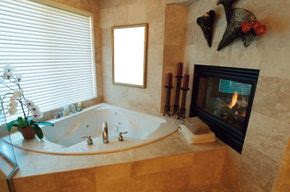
Designing a modern bathroom can be both practical and enjoyable. To ensure the longevity of your bathroom wallcoverings, wooden cabinets, and home insulation, it’s important to include an exhaust fan in your design plans. Fan-only units can be discreetly recessed into a soffit or ceiling, while fan/light combinations are a practical option offering regular lighting or heat lamps.
Once you’ve experienced the warmth provided by a heat lamp after a bath or shower, you’ll never want to be without it! Children and elderly people who feel the cold particularly may appreciate this feature too.
A wall heater in the master bath and an infrared heat lamp located safely in the ceiling of a kids’ bath will keep everyone warm. For a touch of European-style pampering, consider a freestanding or wall-mounted towel warmer, either electrical or connected to your home’s hot-water heating system. If you have the space, a fireplace in the bathroom is the ultimate in luxury heating.
You don’t need a conventional, built-in fireplace with a chimney because several manufacturers offer ventless fireplaces that are both convenient and romantic.
Underfloor radiant heat, whether electrical or from hot-water pipes in the floor, is also a luxurious feature, as heat rises, there are no cold spots in the room. However, portable space heaters should be avoided at all costs.
When it comes to extra features, the sky’s the limit for what your bathroom can include: a built-in TV with VCR, a state-of-the-art audio system to help you relax, a telephone, or even a computer. A security system panel in the bathroom may also be a good idea, especially for an older person who may need to summon help when alone at home.
Visit high-end design centers and home electronics magazines for inspiration. You may find yourself inspired to save on other items to afford a convenience that didn’t exist a few years ago!
Bathroom safety and easy maintenance are essential. On the next page, learn about safety features and how to ensure that your bathroom is easy to keep clean.
For more information on how to decorate or renovate your bathroom, visit:
- Designing a Bathroom
- Kids Bathroom Decorating Ideas
- Home Decorating Tips
Bathroom Safety and Maintenance
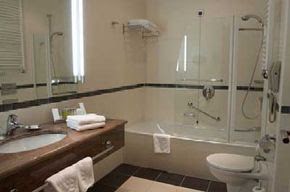
Bathroom safety and future maintenance require careful consideration.
Nonslip flooring, handrails or grab bars for tubs and showers, pressure-balancing valves on showerheads to protect against scalding, and tempered glass for shower doors are some of the safety basics your installer should consider nonnegotiable.
Another important safety feature required by building codes is a GFCI (ground fault circuit interrupter) for any outlet near a water source. If there’s an electrical short, such as a hair dryer falling into the tub, a GFCI will instantly shut off the power.
Inevitably, baths require maintenance, so it’s best to make it easy. The ideal bath layout, from a plumber’s perspective, is to have the water supply and drain/waste/vent pipes all in one wall. This way, repairs are simpler to carry out with only one “wet wall” to deal with. If your bath has fixtures on two or three walls, the next best option is to keep water lines and shut-off valves accessible, just in case you or a plumber needs to get to them. This applies even to whirlpool tubs installed into a tile-covered platform: a hatch should be planned near the controls, which can be opened when required. For regular maintenance, it’s important to know how to clean each component, such as gold-plated faucets, marble counters, hand-painted sinks, and wood-paneled walls, to avoid damage from harsh cleaning chemicals. For more information on decorating or remodeling your bathroom, visit “Designing a Bathroom,” “Kids Bathroom Decorating Ideas,” and “Home Decorating Tips.” The author of this article, Mary Wynn Ryan, has written several interior design books, including “The Ultimate Kitchen,” “The Ultimate Bath,” “Cottage Style,” “Fresh Country Style,” and “Garden Style.” She has also written about home furnishings and interior design for various magazines and was the Midwest editor of Design Times magazine. Additionally, she served as the director of consumer and trade marketing for the Chicago Merchandise Mart’s residential design center and is the president of Winning Ways Marketing, an editorial and marketing consulting firm specializing in home design and decorating.
FAQ
1. What are some affordable ways to decorate a bathroom?
There are many affordable ways to decorate a bathroom. One easy way is to add some colorful towels or a new shower curtain to give the space a fresh look. You can also add some plants or a small vase of flowers to bring some natural elements into the space. Adding some artwork or a framed mirror can also give the bathroom a unique touch.
2. How can I make a small bathroom look bigger?
There are several ways to make a small bathroom look bigger. One way is to use lighter colors on the walls and floors to create a more open and airy feel. Mirrors can also be used to create the illusion of more space. Adding shelving or storage to keep clutter off the floor can help make the space appear larger as well.
3. What are some trendy bathroom decorating ideas?
Some trendy bathroom decorating ideas include using bold wallpaper or patterned tiles to make a statement. Adding brass or gold accents can also add a touch of luxury to the space. Using natural materials like wood or stone can create a spa-like feel. Another trend is to use unique lighting fixtures or statement mirrors to add interest to the space.
4. How can I decorate a bathroom with limited storage space?
If you have limited storage space in your bathroom, there are still ways to decorate the space. Consider using floating shelves or baskets to keep toiletries and towels organized. You can also use a small stool or ladder to hold towels or magazines. Hanging hooks on the back of the door or on the wall can also provide additional storage space.
5. What are some ways to add a pop of color to a neutral bathroom?
If you have a neutral bathroom, adding a pop of color can give the space some personality. Consider adding brightly colored towels or a patterned rug to the floor. You can also use colorful artwork or a statement mirror to add interest to the walls. Adding a plant or vase of flowers in a bright color can also add some life to the space.

Brody is a skilled craftsman and gardening expert. From renovating living spaces to cultivating lush gardens, Brody’s knowledge and passion shine through, inspiring readers to embark on their own home improvement and gardening journeys with confidence.






Leave a Reply